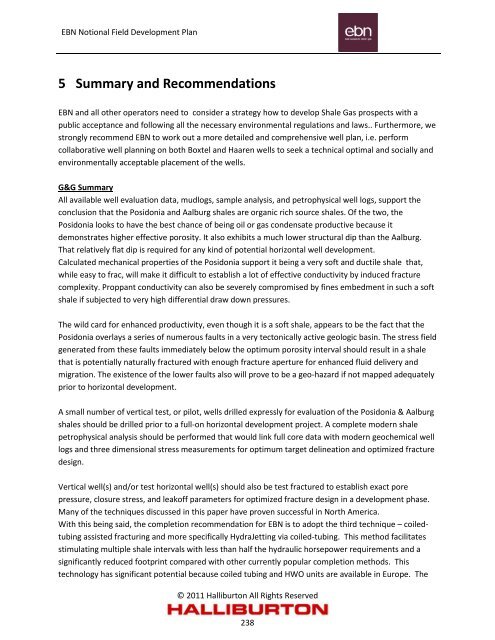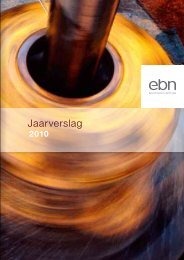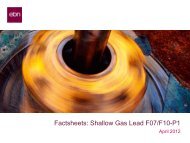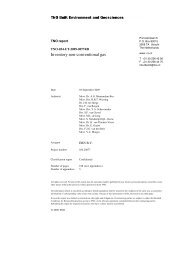Notional Field Development Final Report - EBN
Notional Field Development Final Report - EBN
Notional Field Development Final Report - EBN
Create successful ePaper yourself
Turn your PDF publications into a flip-book with our unique Google optimized e-Paper software.
<strong>EBN</strong> <strong>Notional</strong> <strong>Field</strong> <strong>Development</strong> Plan<br />
5 Summary and Recommendations<br />
<strong>EBN</strong> and all other operators need to consider a strategy how to develop Shale Gas prospects with a<br />
public acceptance and following all the necessary environmental regulations and laws.. Furthermore, we<br />
strongly recommend <strong>EBN</strong> to work out a more detailed and comprehensive well plan, i.e. perform<br />
collaborative well planning on both Boxtel and Haaren wells to seek a technical optimal and socially and<br />
environmentally acceptable placement of the wells.<br />
G&G Summary<br />
All available well evaluation data, mudlogs, sample analysis, and petrophysical well logs, support the<br />
conclusion that the Posidonia and Aalburg shales are organic rich source shales. Of the two, the<br />
Posidonia looks to have the best chance of being oil or gas condensate productive because it<br />
demonstrates higher effective porosity. It also exhibits a much lower structural dip than the Aalburg.<br />
That relatively flat dip is required for any kind of potential horizontal well development.<br />
Calculated mechanical properties of the Posidonia support it being a very soft and ductile shale that,<br />
while easy to frac, will make it difficult to establish a lot of effective conductivity by induced fracture<br />
complexity. Proppant conductivity can also be severely compromised by fines embedment in such a soft<br />
shale if subjected to very high differential draw down pressures.<br />
The wild card for enhanced productivity, even though it is a soft shale, appears to be the fact that the<br />
Posidonia overlays a series of numerous faults in a very tectonically active geologic basin. The stress field<br />
generated from these faults immediately below the optimum porosity interval should result in a shale<br />
that is potentially naturally fractured with enough fracture aperture for enhanced fluid delivery and<br />
migration. The existence of the lower faults also will prove to be a geo-hazard if not mapped adequately<br />
prior to horizontal development.<br />
A small number of vertical test, or pilot, wells drilled expressly for evaluation of the Posidonia & Aalburg<br />
shales should be drilled prior to a full-on horizontal development project. A complete modern shale<br />
petrophysical analysis should be performed that would link full core data with modern geochemical well<br />
logs and three dimensional stress measurements for optimum target delineation and optimized fracture<br />
design.<br />
Vertical well(s) and/or test horizontal well(s) should also be test fractured to establish exact pore<br />
pressure, closure stress, and leakoff parameters for optimized fracture design in a development phase.<br />
Many of the techniques discussed in this paper have proven successful in North America.<br />
With this being said, the completion recommendation for <strong>EBN</strong> is to adopt the third technique – coiledtubing<br />
assisted fracturing and more specifically HydraJetting via coiled-tubing. This method facilitates<br />
stimulating multiple shale intervals with less than half the hydraulic horsepower requirements and a<br />
significantly reduced footprint compared with other currently popular completion methods. This<br />
technology has significant potential because coiled tubing and HWO units are available in Europe. The<br />
© 2011 Halliburton All Rights Reserved<br />
238







